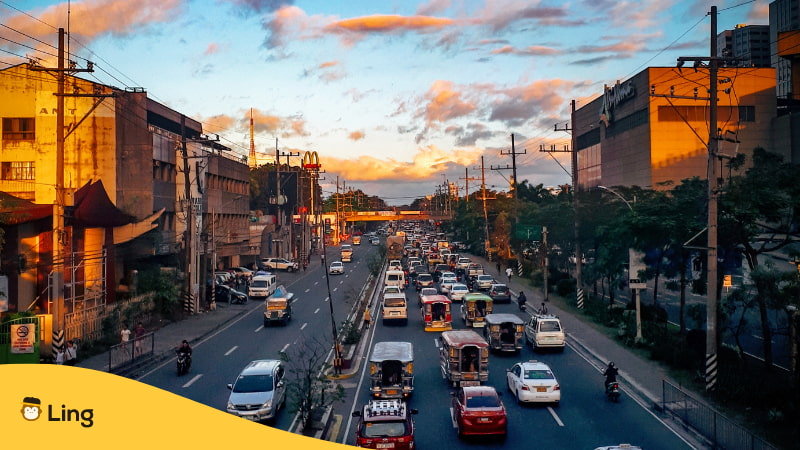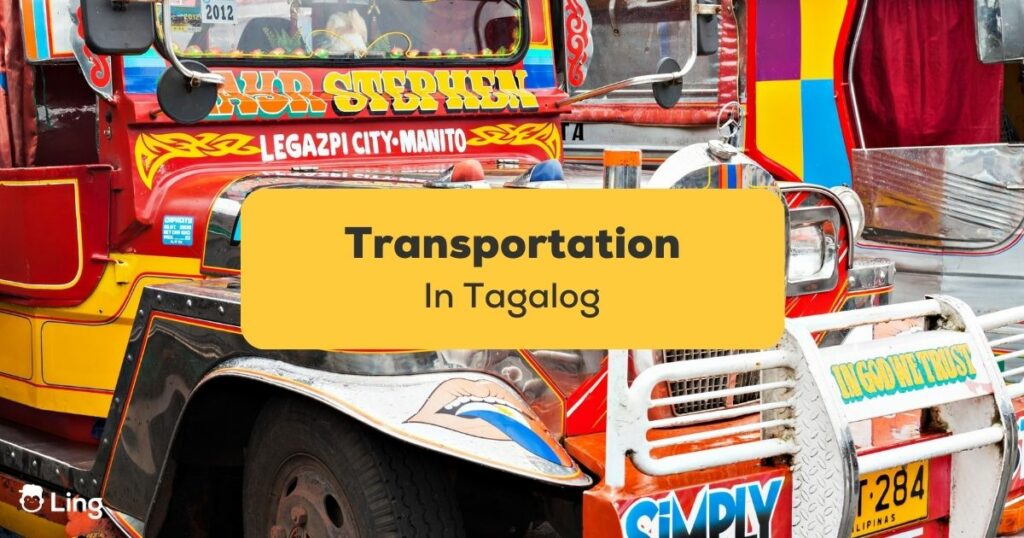When visiting a country, learning about transportation is important. So, worry no more because today, we will learn about transportation in Tagalog.
Going around the Philippines will be a lot easier when you know their transportation system. The Philippines, just like any other country, has different transportation systems to go from one location to another. These transportation services are also used for moving goods to different places in the country.
Learning different transportation and related words in Tagalog will give you a lot of advantages. First, you’ll get to move around the country and the city easily and conveniently. It will also help you build your vocabulary since you’ll really encounter a lot of people and pick up a lot of words. Lastly, it will also help you to save money by choosing cheaper transportation when moving around.
So, in this blog, we will talk about transportation in Tagalog. Every vocabulary word that you will learn will have an English word translation, so you don’t need to worry about it.
- What Is Transportation In Tagalog?
- Common Transportation In Tagalog
- Other Transportation Vehicle In Tagalog
- Tagalog Vocabulary Related To Transportation
- Going Around The Philippines? Learn Tagalog Now!
What Is Transportation In Tagalog?
Transportation refers to a facility consisting of tools and equipment needed to move people or goods. It can also be defined as the commercial enterprise of moving goods and materials. Before anything else, let’s first learn how to say the word transportation in Tagalog. Filipinos use transportation, which sounds almost the same as the English word.
However, in normal conversations, you won’t hear people saying, “Ano ang transportasyon papuntang mall?” which is translated to “What is the transportation going to the mall?”. Instead, you will hear them use “sasakyan,” which is translated as “vehicle” in English.
Common Transportation In Tagalog
Now that you have learned how to say transportation in Tagalog, let’s now discover some basic modes of transportation.
Jeepney / Dyip /
Your trip to the Philippines will never be complete if you haven’t experienced riding a jeepney. This is probably the most common and popular land transportation in the Philippines. They are well-known for their cramped sitting arrangements and garish décor, both of which have become widely recognized symbols of the culture and art of the Philippines. As of now, the minimum fare in jeepneys is ₱11.00, which is $0.19.
Taxi
This next transportation lines with the expensive ones. Most taxis in the Philippines are white in color. However, when you’re at the airport, the taxi that you will usually see is color yellow. Just a tip, when you ride a taxi, make sure to ask that the whole ride should be metered. “You can say, “Paki-metro po.” which means “Please use the meter for the whole ride.”. This will save you from over-pricing.

Kotse
The word “kotse” is the Tagalog word for “car.” In the Philippines nowadays, it’s convenient to have a car because it’s hard to commute, but the price of fuel has risen because of inflation. Another problem that car owners face nowadays is the heavy traffic, especially in Metro Manila; that’s why when you own a car in the Philippines, make sure that you have the budget and long patience.
Grab
Can’t find a taxi? You can also book a Grab car if you can’t find a taxi within your area. Grab is a Transportation Network Vehicle Service (TNVS) that provides users with transportation, food delivery, and digital payment services. You should first download the app, and then you can already use it to book transportation.
In booking a Grab vehicle, you can choose from the options: Grab Car (4 seaters), Grab car (6 seaters), or Grab Taxi. This is pricey compared to the regular taxi that you’ll see along the streets. But, if you want convenience, especially during rush hours, this will save you from lining up on public transportation.
MRT, LRT, And PNR
Another common public transportation in the Philippines is the train. There are three major rapid transit systems serving Metro Manila. The first one is the MRT or Manila Metro Rail Transit System which travels along EDSA, crossing different cities from Pasay City to Quezon City.
The next one is the LRT or Manila Light Rail Transit System. It is a rail transit system that serves Metro Manila in the Philippines. The network comprises two lines: the old Line 1 or Green Line and the more contemporary Line 2 or Blue Line. The LRT-1 has 20 stations, and it runs from Monumento Station to Baclaran Station. On the other hand, the LRT-2 has 13 stations, and it runs from Recto (Manila) to Antipolo (Rizal).
The Philippine National Railways is a state-owned railroad company in the Philippines. It runs one commuter rail service between Metro Manila and Laguna and local services between Sipocot, Naga, and Legazpi in the Bicol Region.
Angkas And Joyride /
Aside from cabs and cars, you can also book a motorcycle ride in the Philippines. This option is a lot cheaper than taxi cabs and Grab. You will also reach your destination faster than using other transportation. The two leading motorcycles in the Philippines are Angkas and Joyride. To use this, just download the app, and you can already book a ride.
Pedicab
For short-distance rides, pedicabs are great and cheap options. It is a small vehicle that is propelled by pedaling, and it functions as a taxi service and a local mode of transportation. There’s no definite fare on pedicabs, but it usually ranges from 20 pesos per person and up.
Bisikleta
The word “bisikleta” means “bicycle” in English. When the COVID-19 pandemic happened, many people resided using bicycles to go to work because there was no public transportation. Nowadays, there are still lots of people who are using bicycles to go to work, school, and other places.
Tricycle
Tricycles are also one of the common modes of transportation in the Philippines. This is available for short distances only, usually in a small barangay or town. When you ride a tricycle, the driver will make you choose if special means you’re the only passenger or not, meaning the driver will still wait for other passengers.
Eroplano
For air transportation, of course, we have the “eroplano” or airplane in English. Some of the major airlines in the Philippines are Philippine Airlines, Cebu Pacific, and Air Asia. If you’re traveling by air, learning some Tagalog airport vocabulary will be a big help.
Barko / Bangka /
For maritime transportation, we have the word “barko” or ship in English. But, if you have heard the word “bangka,” it means boat. Since the Philippines is composed of 7,107 islands, there are many tourist destinations where you’ll get to ride a ship or a boat.

Kalesa
Lastly, we have the kalesa. It is also an important part of Filipino culture. It is basically a carriage. You won’t be seeing much of this in urban areas aside from Manila, the capital city of the Philippines. When you go to Intramuros, you can see and ride a kalesa.
Other Transportation Vehicle In Tagalog
For transporting goods and products, people often use trucks (trak) and ships (barko). But nowadays, delivery services are now used such as the following:
- Lalamove
- Transportify
- Grab Express

Tagalog Vocabulary Related To Transportation
After learning some Transportation in Tagalog, let us now move to different words and phrases related to it. It’s not enough that you just know about transportation. You should also know a few words and phrases.
One great example is the word/expression “para!”. When it comes to transportation, this word has two meanings. The first one is to call for a vehicle. This is usually done by extending one of your arms forward and making a hand gesture like you’re asking someone to come near you but only downwards.
The other meaning of the word “para!” is “to stop.” You’ll say this to the driver to signal to him that you need to get off the vehicle. You can also say “Para po!” or “Sa tabi na lang po.” which means the same also. There are many vocabulary words related to transportation that you’ll need to learn. Here are the most common words that Filipino people use for transportation.
Going Around The Philippines? Learn Tagalog Now!
Given the rich culture and wonderful tourist spots, going from one place to another is something that you can enjoy when you’re in the Philippines. But, it’s more exciting and meaningful when you know how to communicate with the locals. This is why you need to learn Tagalog to connect with Filipinos. Luckily, the Ling app can give you that opportunity while you travel.
The Ling app is a language learning platform that will help language learners achieve their goals. With its advanced features and variety of topics to learn, language learning can be fun and meaningful. No need to carry a Filipino dictionary around you. Just download the app on the Play Store or App Store, and you can start learning anytime and anywhere! So, learn Tagalog with the Ling app now!

















